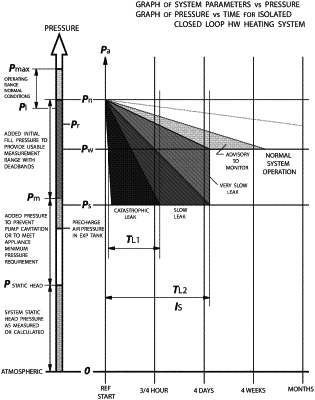| CPC F24D 3/02 (2013.01) [F24D 3/1008 (2013.01); F24D 19/1015 (2013.01); F24D 2220/0271 (2013.01); F24D 2220/042 (2013.01); F24D 2220/046 (2013.01)] | 10 Claims |

|
1. A method of detecting a leak in a closed loop heat transfer system, the method comprising:
a. providing the closed loop heat transfer system, the heat transfer system including,
an appliance for heating or cooling,
a circulator pump,
an expansion tank,
an air separator with an air vent,
one or more radiators,
a normally closed valve coupled to a fluid makeup supply source,
a controller having a processor and memory accessible by the processor,
a first conduit fluidly connecting the appliance, the circulator pump, the air separator and the radiators to form a circulation loop,
a second conduit separate from the circulation loop for fluidly connecting the expansion tank and the normally closed valve to the air separator,
at least one fluid pressure transducer located on the second conduit in operative communication with the controller; and
a fluid contained within the first and second conduits for circulating therein;
b. the controller sampling system pressure through the at least one fluid pressure transducer;
c. the controller evaluating the system pressure and determining the system pressure has fallen to or below a pre-determined pressure value;
d. in response to the system pressure falling to or below the pre-set pressure value, the controller sampling and evaluating system pressures over a pre-determined period of time to determine that the system pressure is not decreasing at or in excess of a pre-determined rapid rate;
e. after the pre-determined period of time has passed, the controller opening the normally closed valve to initiate a fill event, permitting makeup fluid to flow into the first and second conduits and thereby raising the system pressure to a second pre-determined value;
f. the controller logging the date and time of the first fill event operation (e);
g. the controller repeating steps (b)-(f) for one or more instances creating one or more additional fill events;
h. the controller analyzing a frequency of occurrence of the fill events, and
i. the controller providing a notification if the frequency of occurrence exceeds a pre-determined fill event frequency value.
|